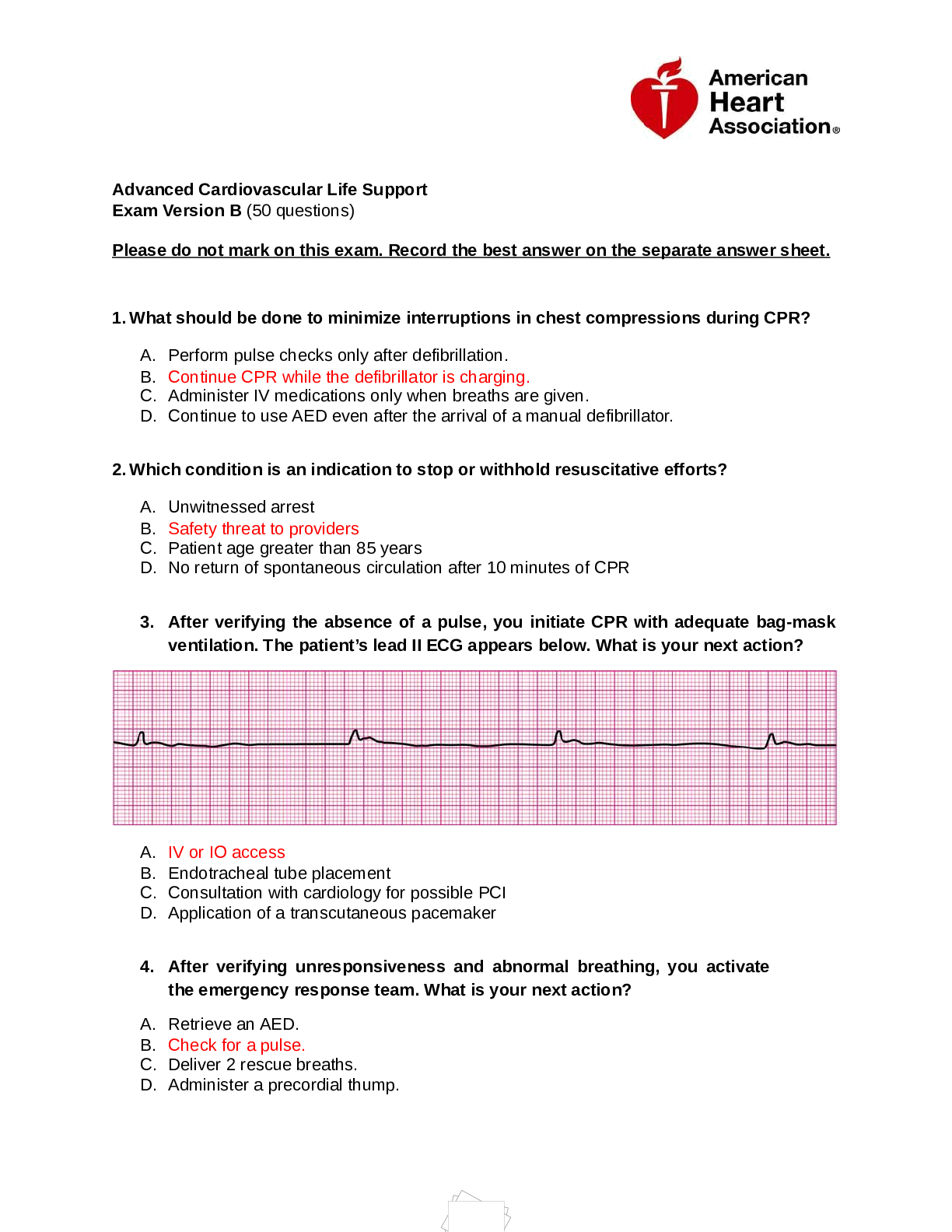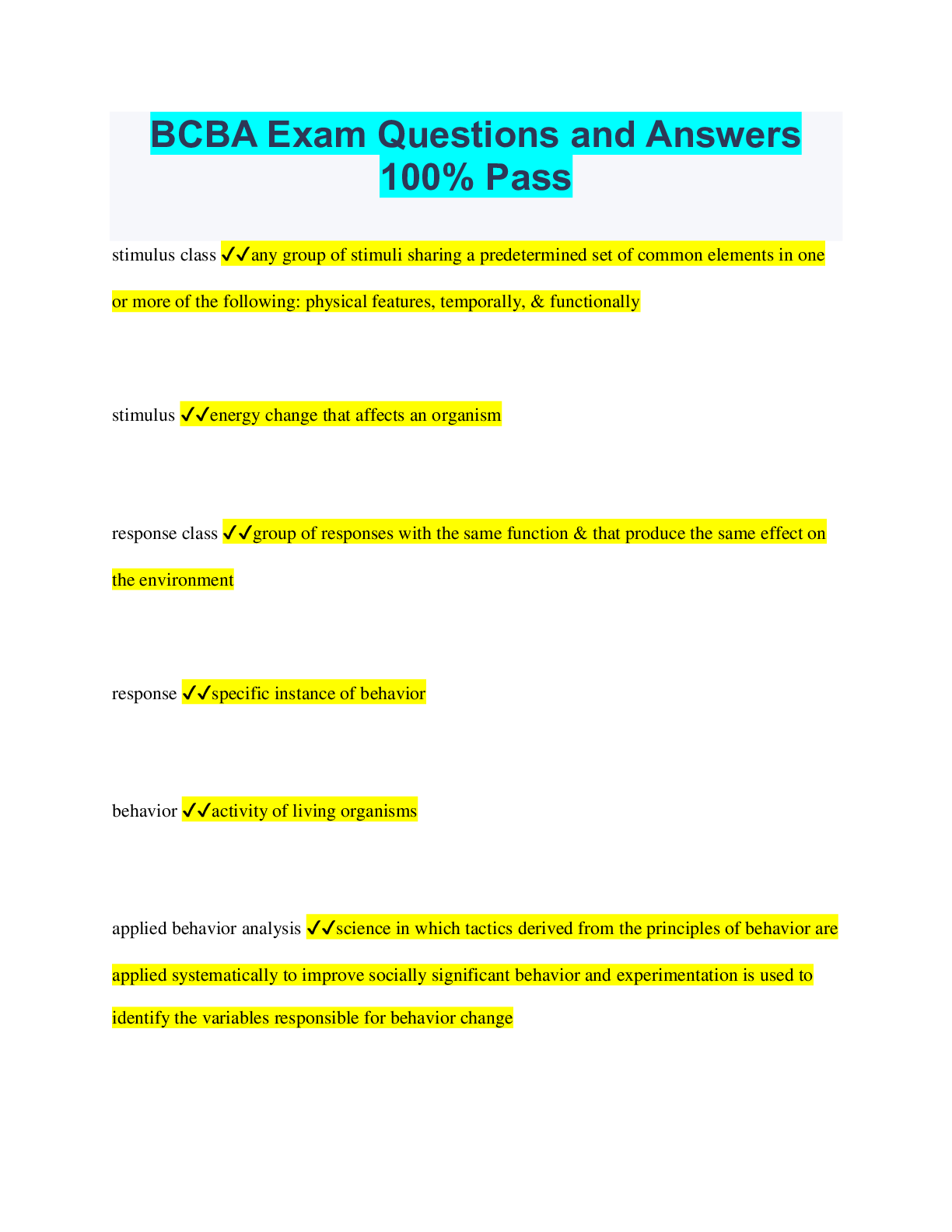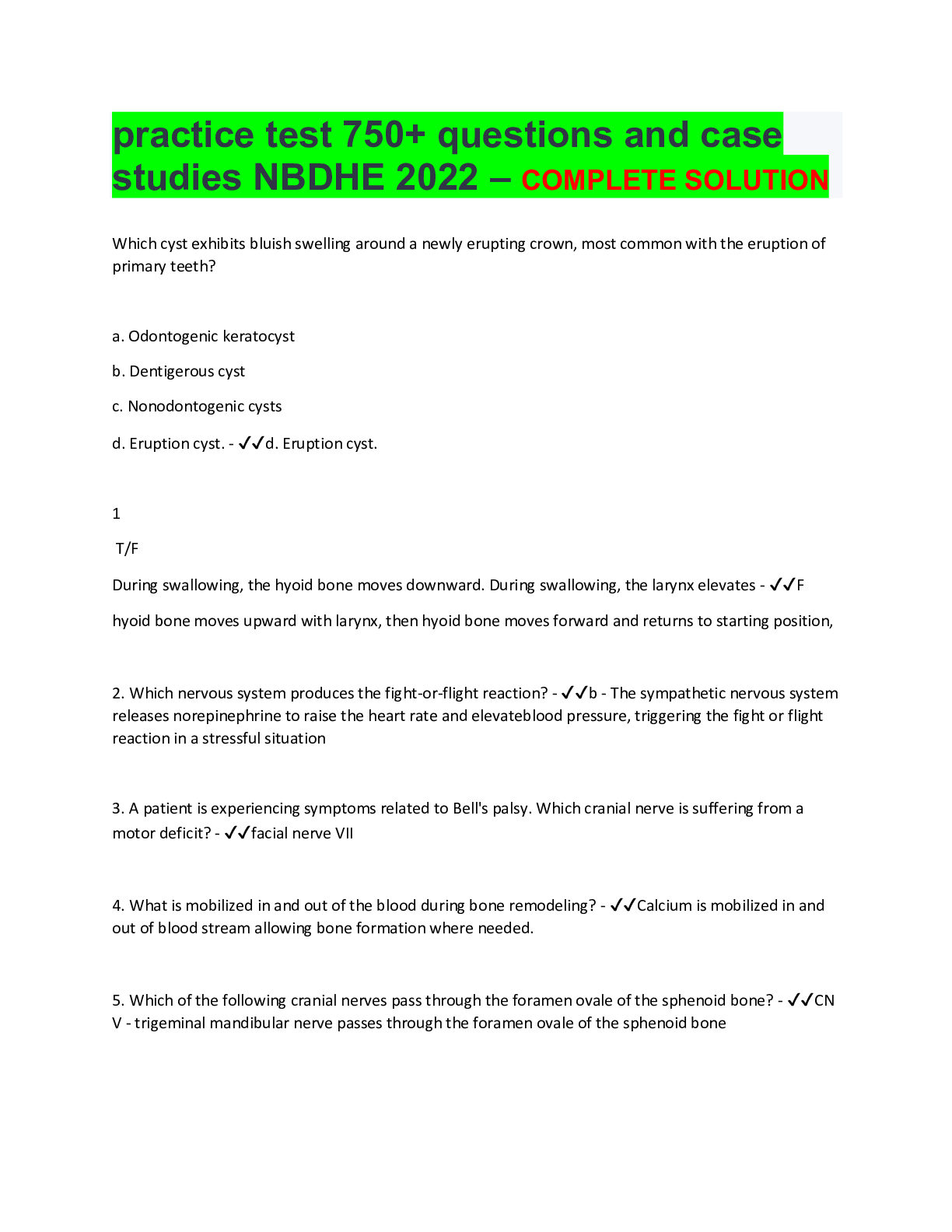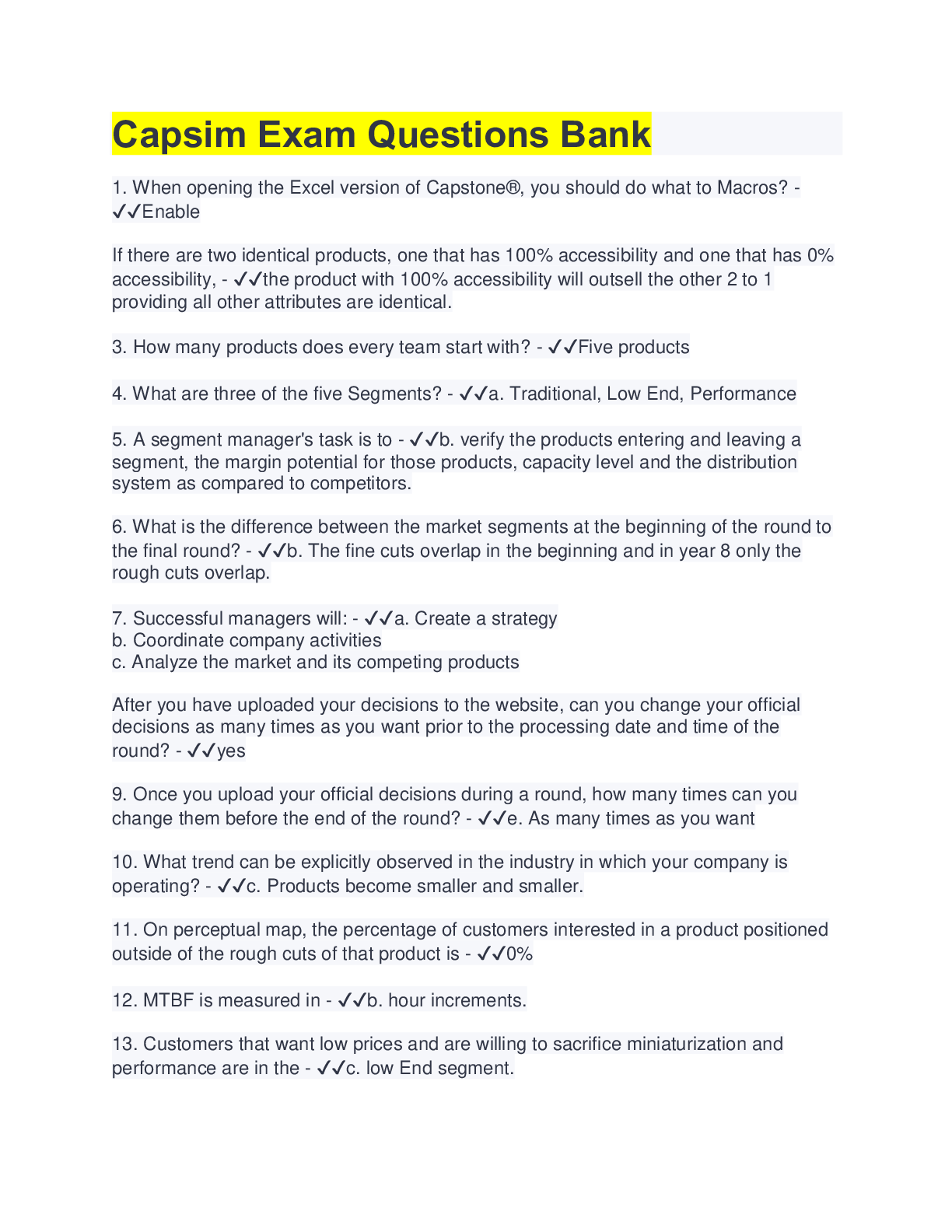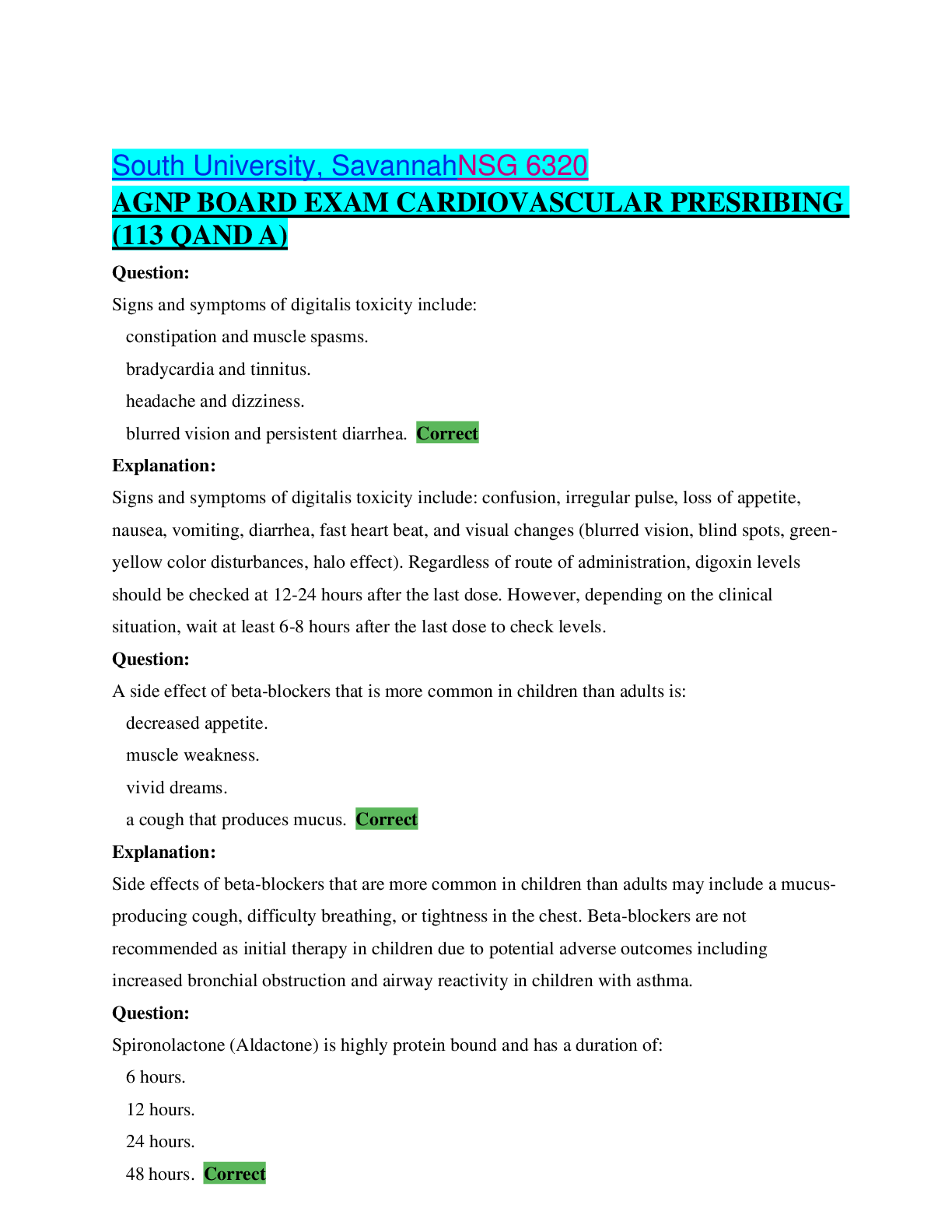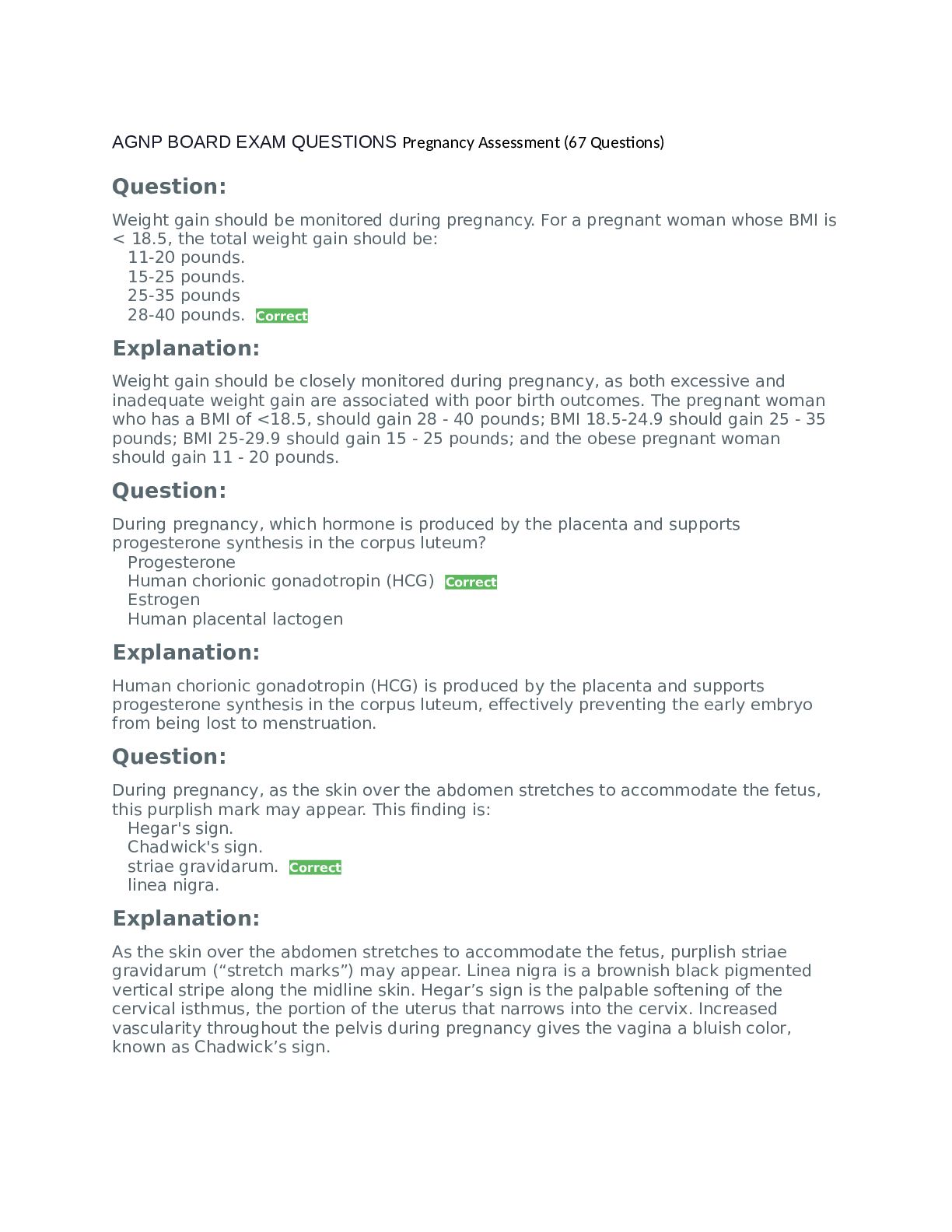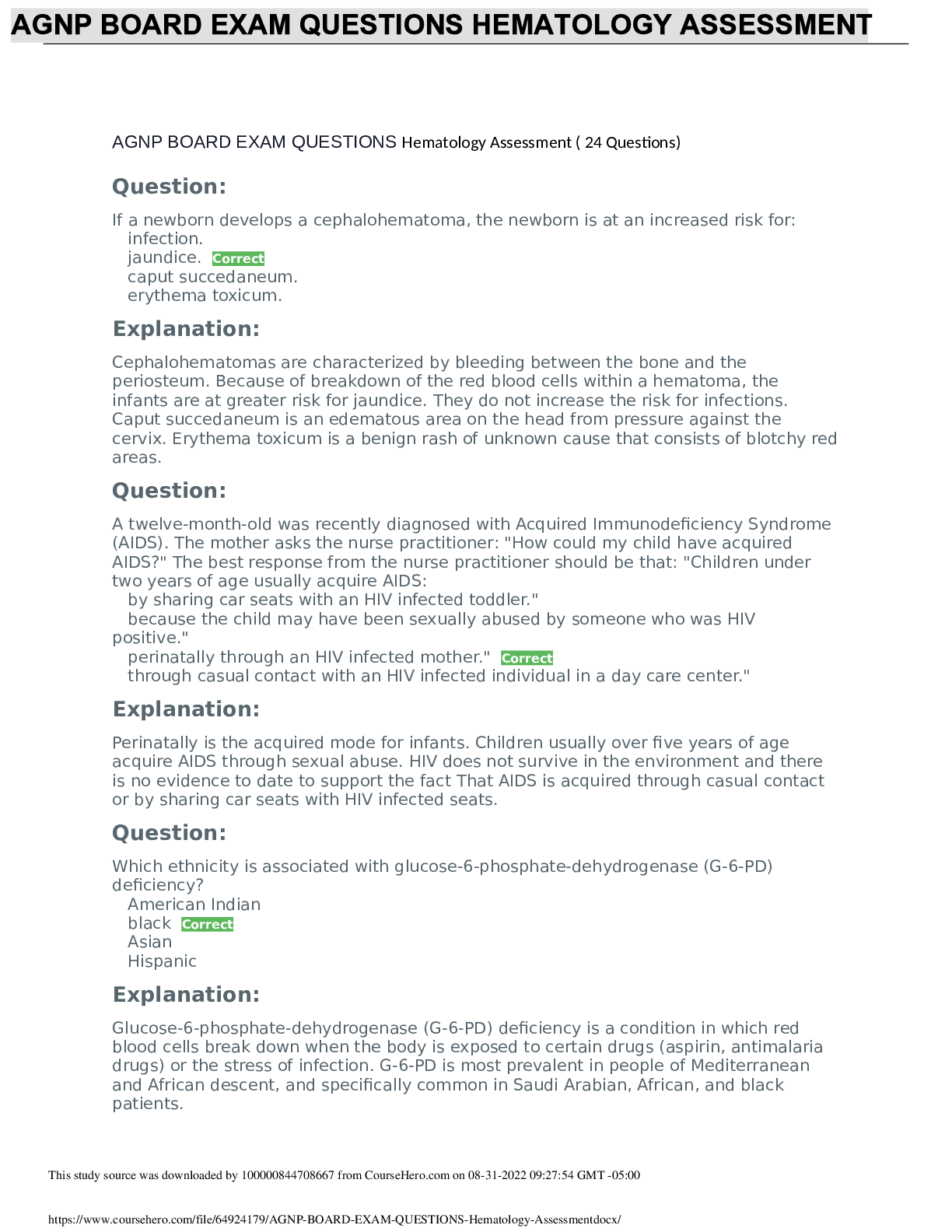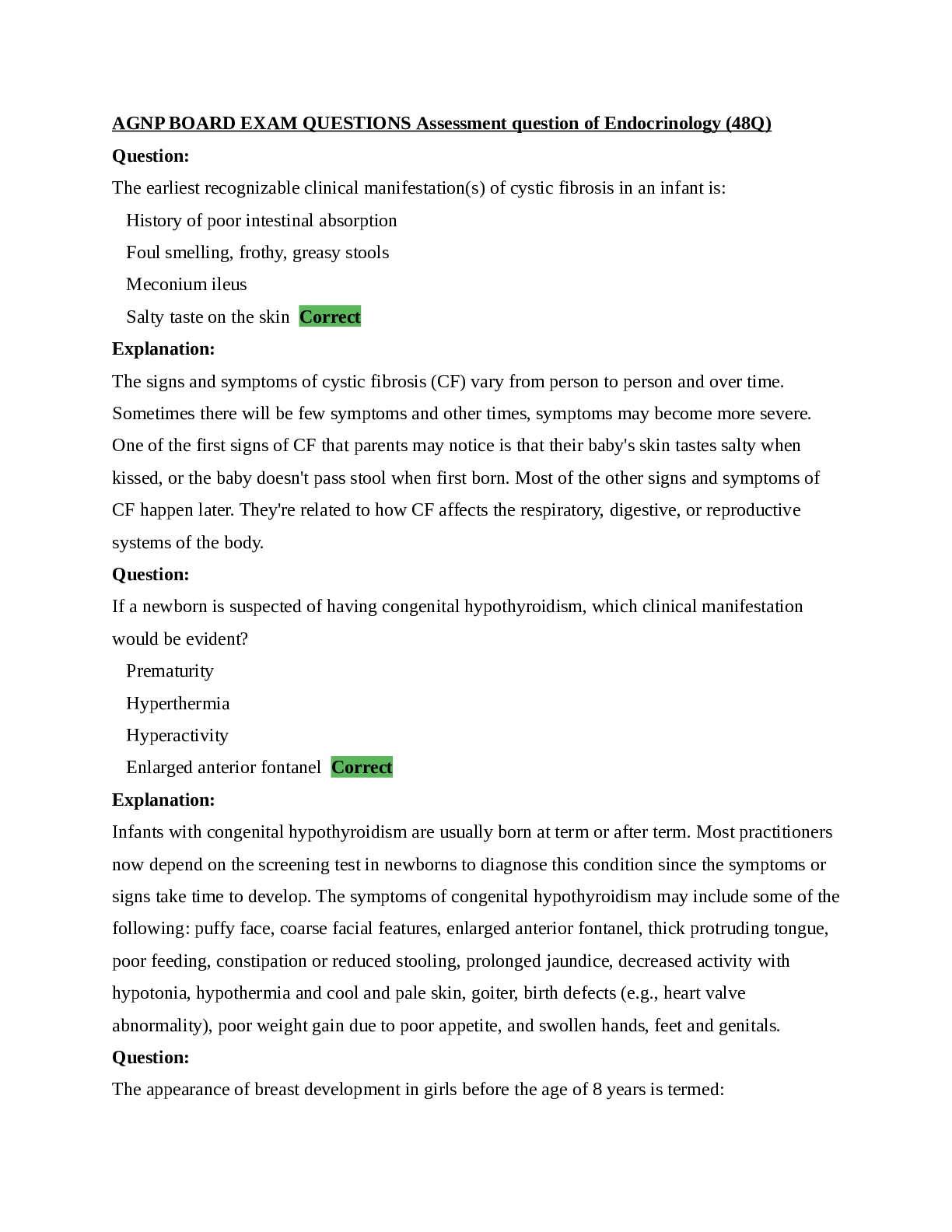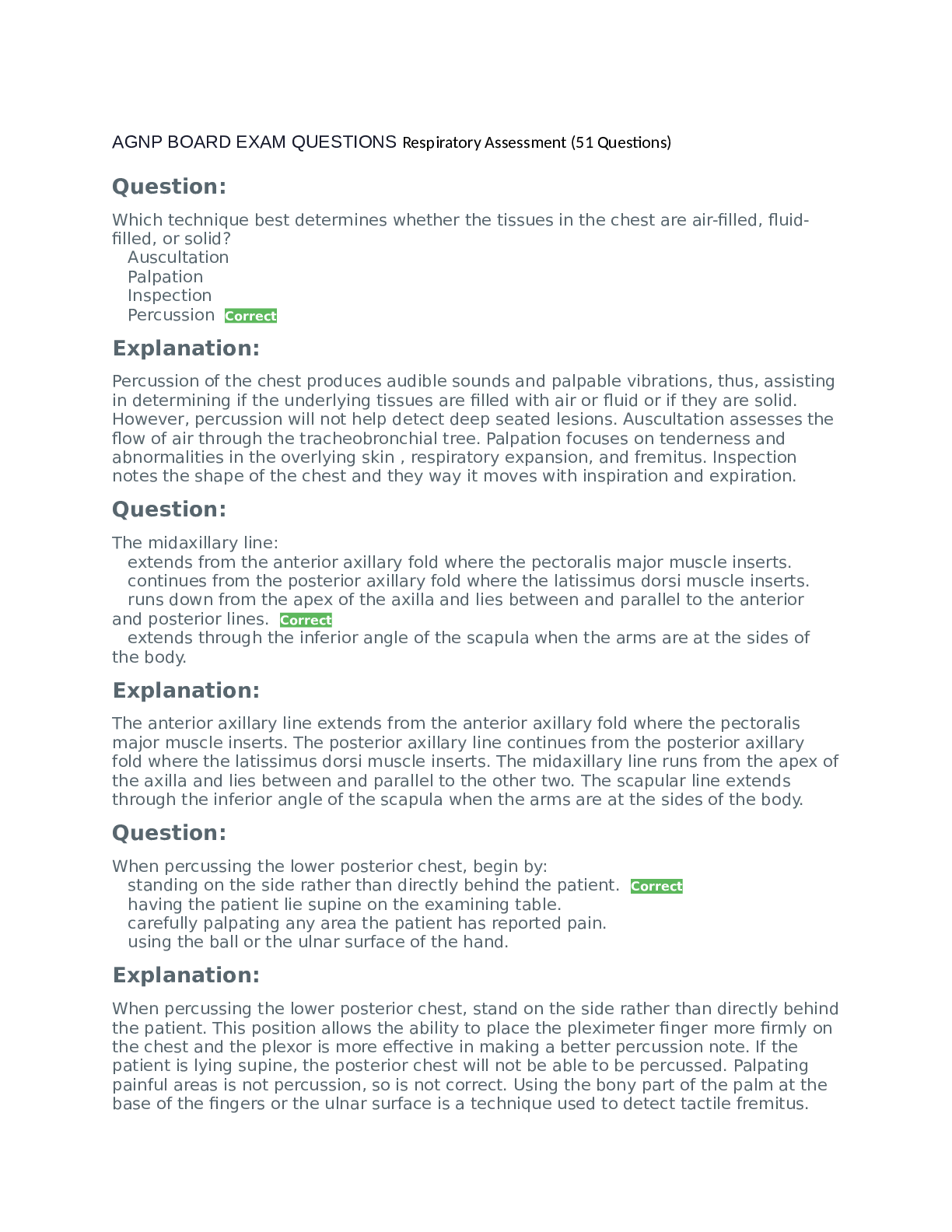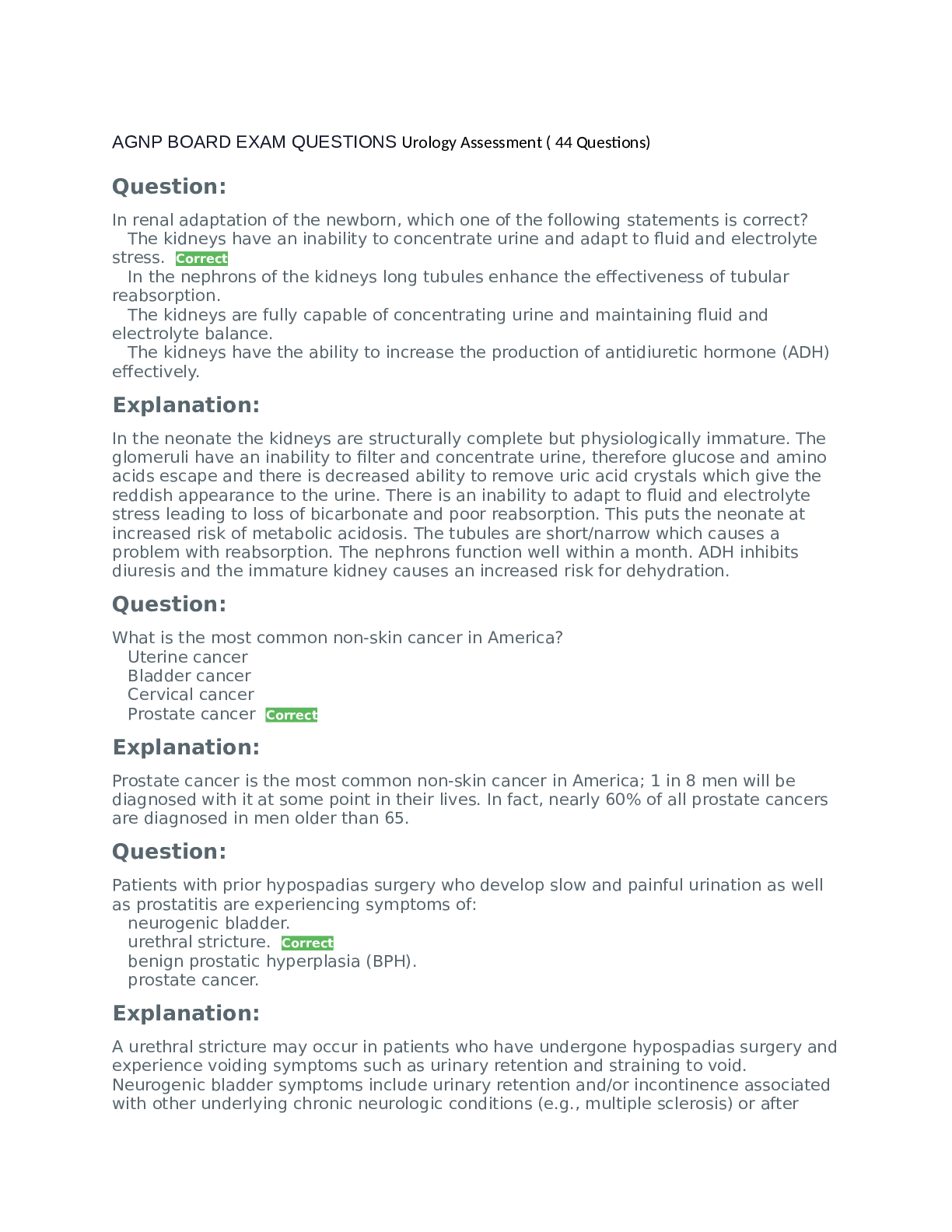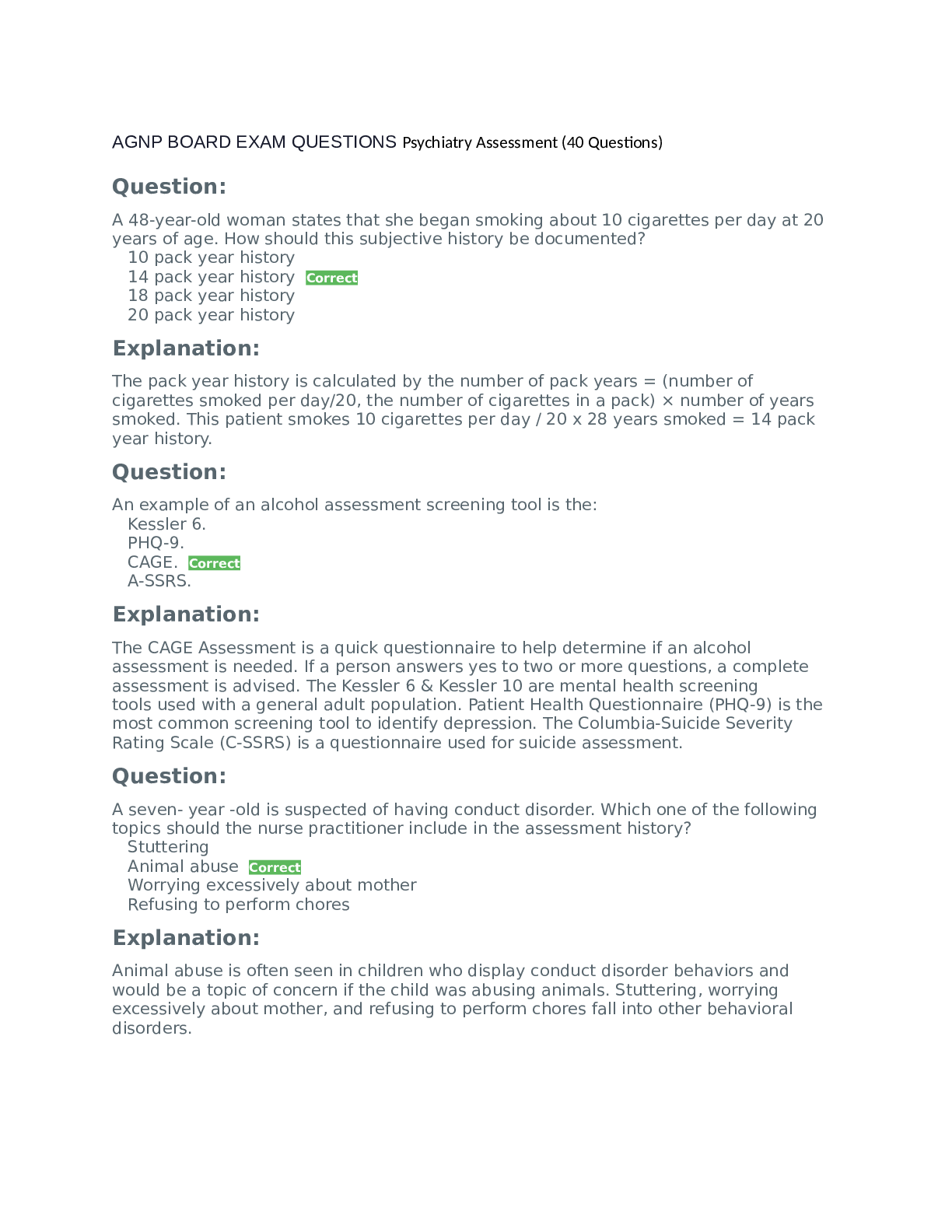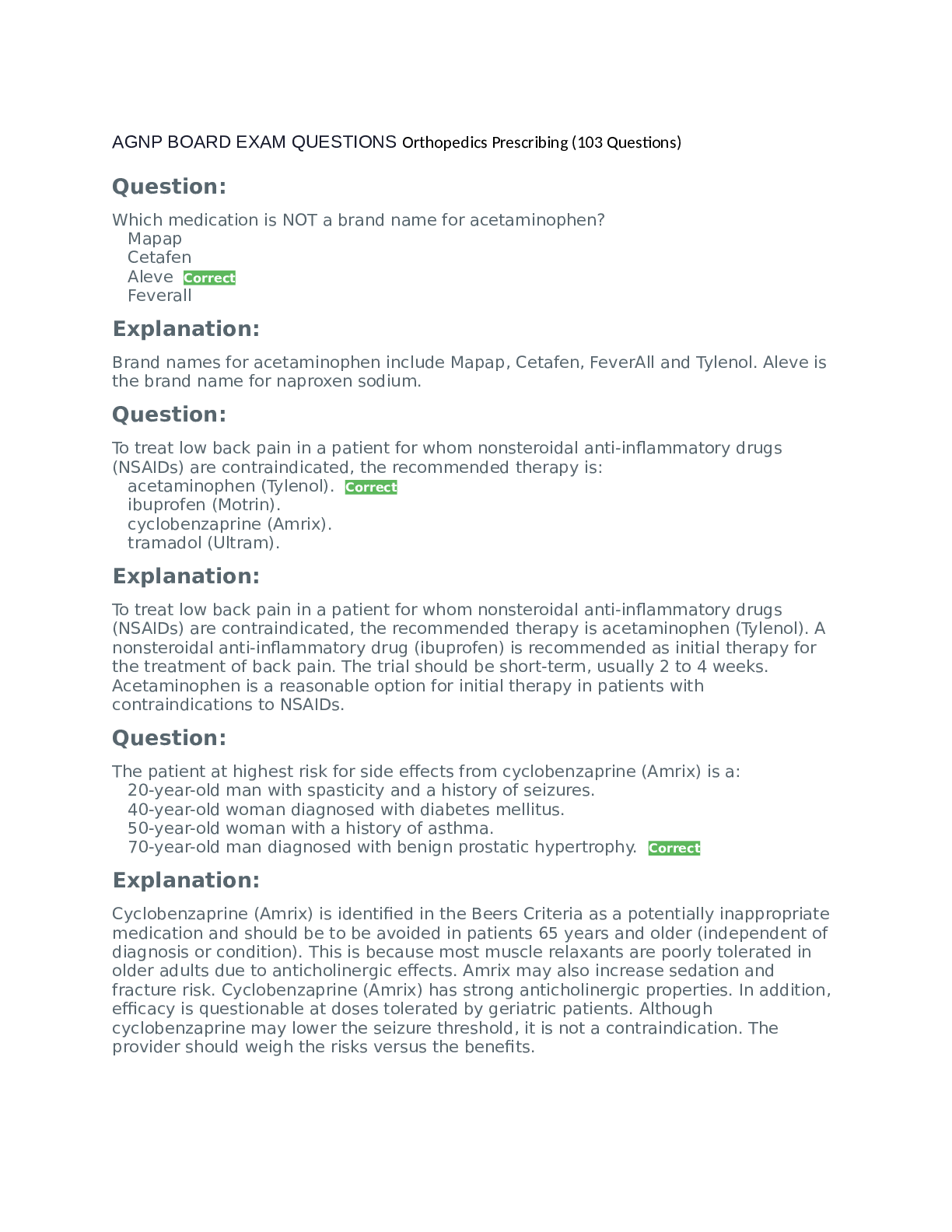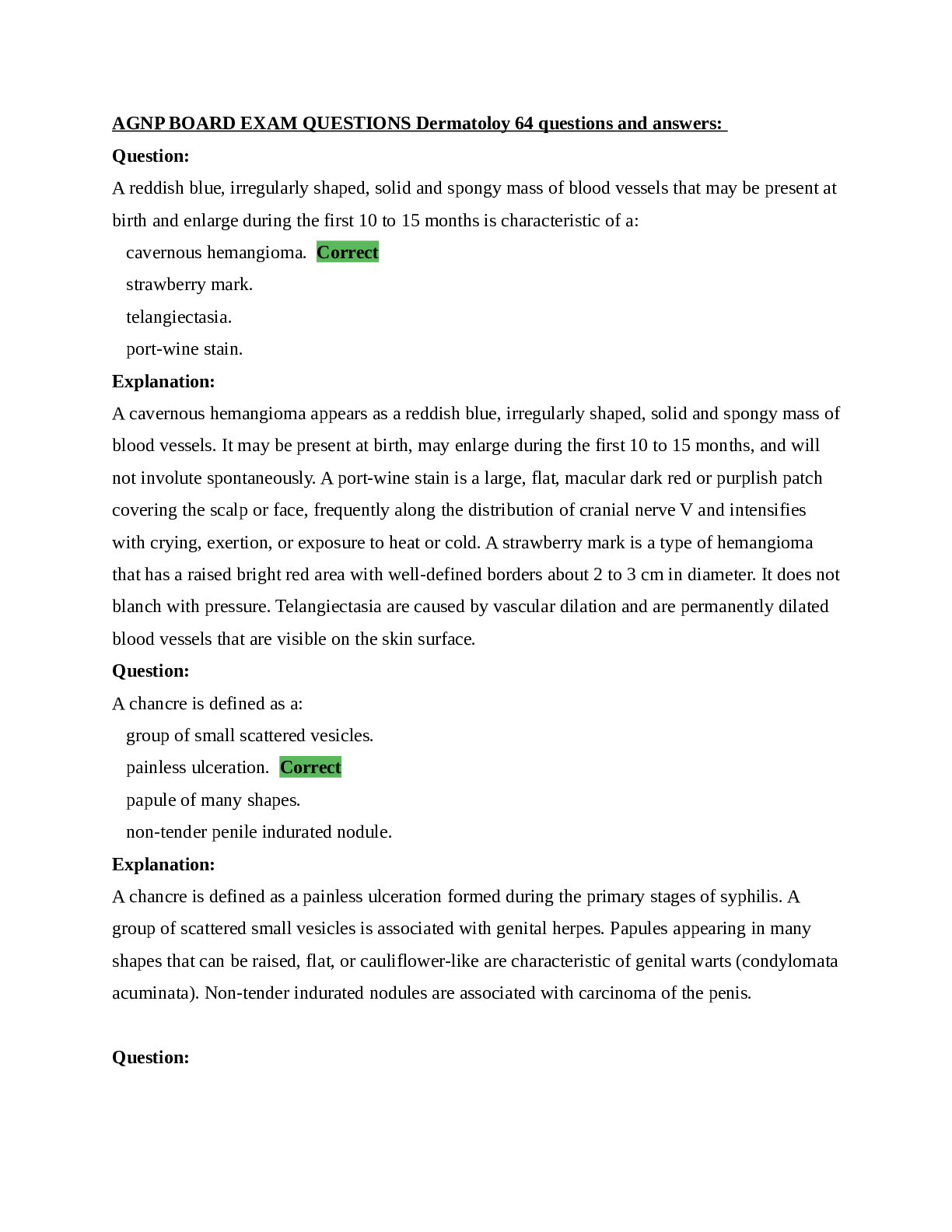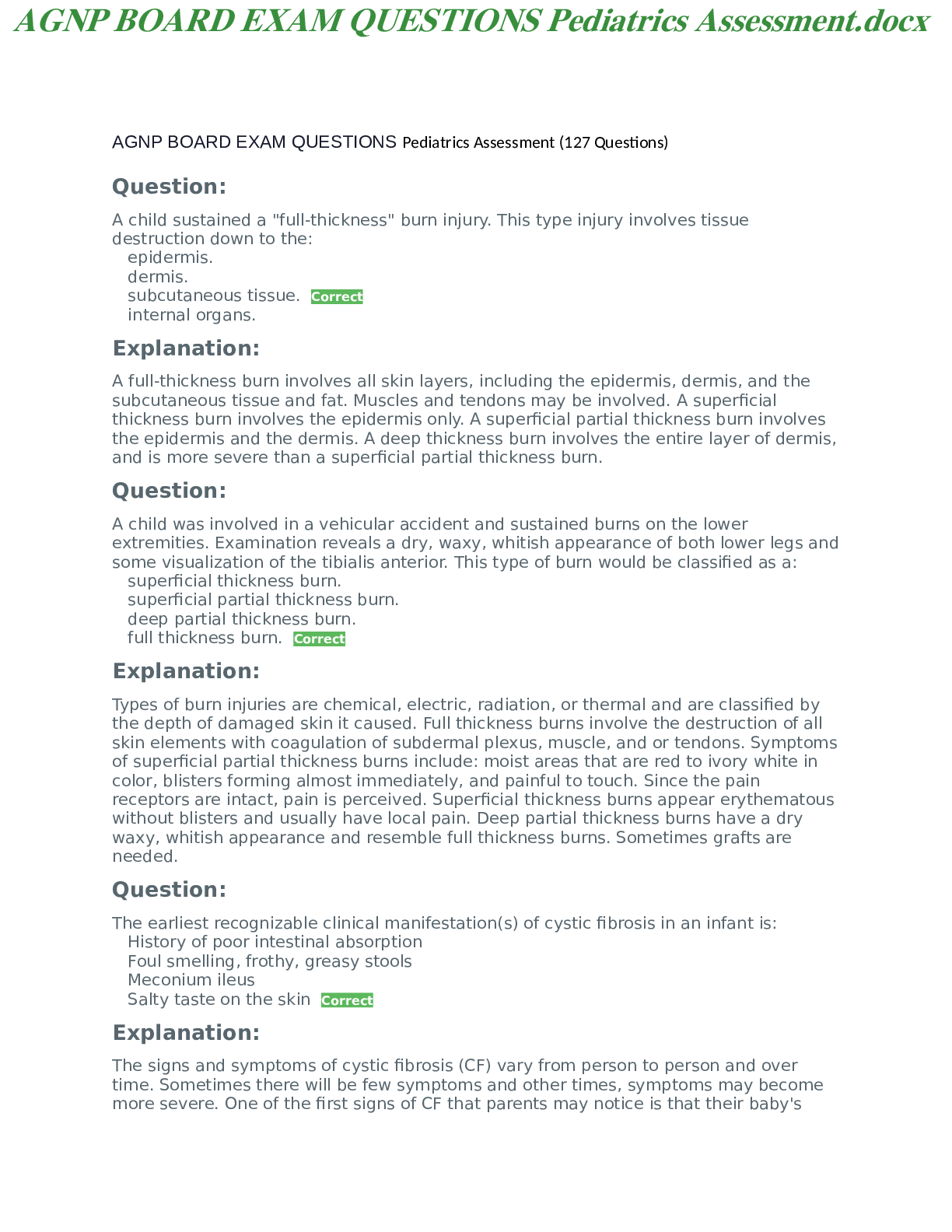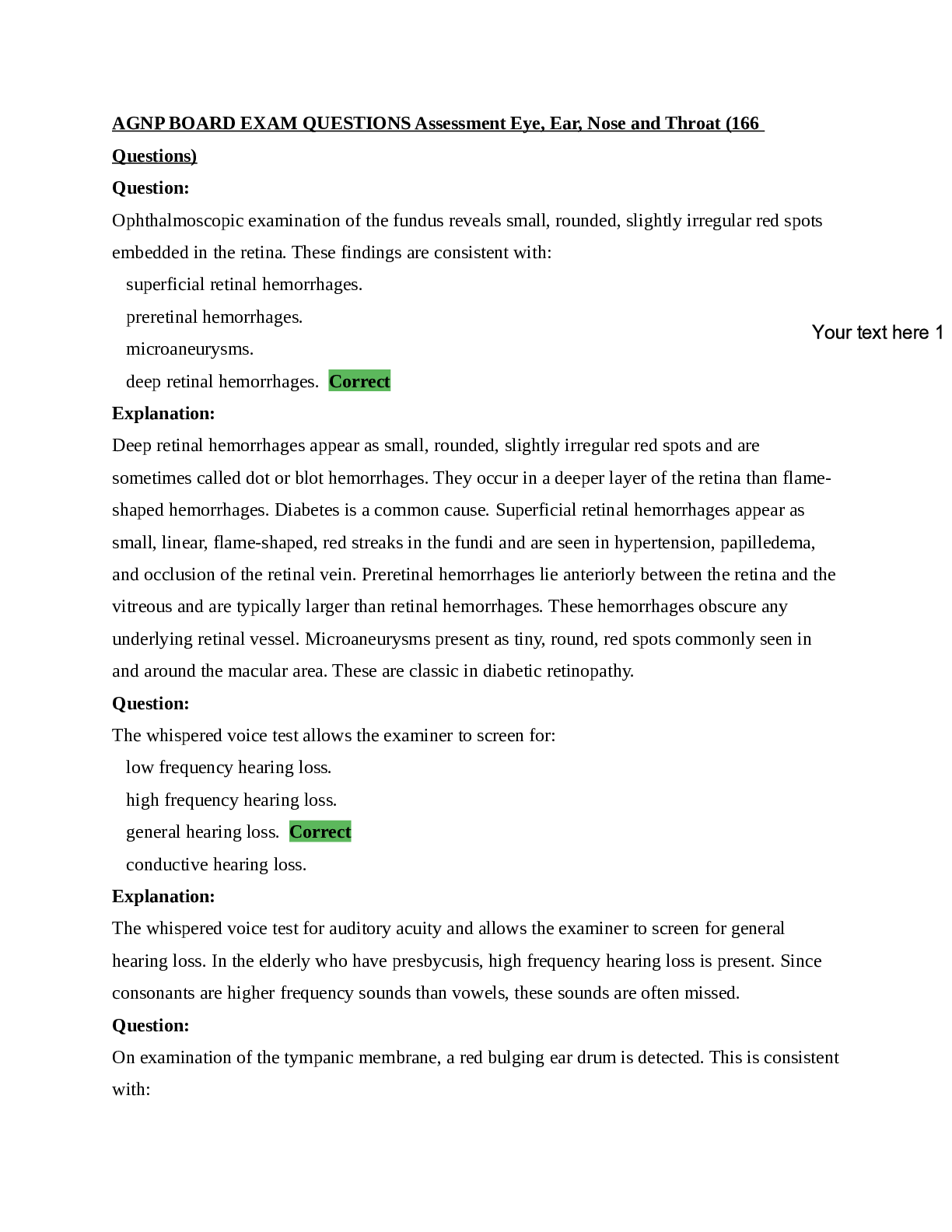*NURSING > QUESTIONS & ANSWERS > South University, Savannah NSG 6320 AGNP BOARD EXAM QUESTIONS Neurology Prescribing Already Passed (All)
South University, Savannah NSG 6320 AGNP BOARD EXAM QUESTIONS Neurology Prescribing Already Passed
Document Content and Description Below
AGNP BOARD EXAM QUESTIONS Neurology Assessment (102 Questions) Question: Which of the following medications is NOT a serotonin 5-HT1 receptor agonist? Axert. Fioricet. Correct Maxalt. Zomig. Ex... planation: Fioricet is a combination of butalbital, acetaminophen and caffeine. Axert (almotriptan), Maxalt (rizatriptan), Zomig (zolmitriptan) are all classified as serotonin 5-HT1 receptor agonists, or triptans. Question: A patient presenting with a transient ischemic attack (TIA) is taking nifedipine (Adalat CC) for hypertension. Pharmacokinetics of nifedipine may be altered in patients with: renal insufficiency. hepatic impairment. Correct irritable bowel disease. G6PD deficiency. Explanation: Since hepatic biotransformation is the predominant route for the disposition of nifedipine, the pharmacokinetics may be altered in patients with chronic liver disease. Patients with hepatic impairment have a longer disposition half-life and higher bioavailability of nifedipine than healthy volunteers. Question: Oxcarbazepine (Trileptal) is structurally similar to: carbamazepine (Tegretol). Correct divalproex sodium (Depakote). lamotrigine (Lamictal). topiramate (Topamax). Explanation: As the name suggests, oxcarbazepine (Trileptal) is related to carbamazepine (Tegretol, Carbatrol) and appears to be similarly effective for controlling complex partial seizures and primary and secondary generalized tonic-clonic seizures. It seems to cause fewer unwanted side effects in many (but not all) patients. Oxcarbazepine is not effective against absence or myoclonic seizures. Question: Patients who experience greater than 7 to 9 tension-type headaches per month may be considered for maintenance therapy including: anticonvulsants and tricyclic antidepressants. antidepressants and beta-blockers. anticonvulsants and muscle relaxants. muscle relaxants and tricyclic antidepressants. Correct Explanation: Patients who experience greater than 7 to 9 tension-type headaches per month may be considered for maintenance therapy including muscle relaxants (i.e., tizanidine) and tricyclic antidepressants (i.e., amitriptyline). Muscle relaxants are considered secondline therapy to be added to TCAs if inadequate in reducing headache episodes. Antiepileptics and beta-blockers may be indicated for the prophylactic treatment of migraines. There is more evidence of effectiveness with amitriptyline than doxepin, or with other antidepressants such as venlafaxine and mirtazapine. Doses used are generally low and not in the range used to treat depression. The need for continued chronic treatment of tension-type headaches should be reviewed at least every 6 months. Question: Beta-blockers, used for the prophylactic treatment of migraines, would NOT be contraindicated in a patient with a history of: ventricular arrhythmias. 2nd degree heart block. pulmonary congestion. acute coronary syndrome. Correct Explanation: Beta-blockers are contraindicated in patients who have a history of ventricular arrhythmias, sick sinus syndrome, 2nd or 3rd degree heart block, cardiogenic shock, and pulmonary congestion. Beta-blockers are indicated in acute coronary syndrome in order to prevent recurrent ischemia and life-threatening ventricular arrhythmias. Question: Patients who are taking carbidopa/levodopa (Sinemet) for Parkinson's disease should be advised to avoid a diet high in: carbohydrates. fat. protein. Correct sodium. Explanation: Since levodopa competes with certain amino acids for transport across the gut wall, the absorption of levodopa may be impaired in some patients on a high-protein diet. The patient should be advised that a change in diet to foods that are high in protein may delay the absorption of levodopa and may reduce the amount taken up in the circulation. Excessive acidity also delays stomach emptying, thus delaying the absorption of levodopa. Iron salts (such as in multivitamin tablets) may also reduce the amount of levodopa available to the body. The above factors may reduce the clinical effectiveness of the levodopa or carbidopa levodopa therapy. Question: Which of the following statements is NOT true about antiepileptic drugs (AEDs)? Antiepileptics should be withdrawn gradually. Antiepileptics may increase the risk of suicidal thoughts. Dosing of antiepileptics should be based on therapeutic drug levels. Correct The pharmacokinetics of antiepileptics are influenced by age, especially during childhood. Explanation: Due to individual variation, many patients may require concentrations outside the reference ranges. Dosing of antiepileptic drugs (AEDs) is best defined as the concentration at which a person achieves the best compromise between improvement in seizure control and concentration-related adverse effects. All antiepileptic drugs should be withdrawn gradually to minimize the potential for increased seizure frequency. AEDs may increase the risk of suicidal thoughts or behavior in patients taking these drugs for any indication. The pharmacokinetics of AEDs are markedly influenced by age, especially during infancy and childhood. For most AEDs studied in infants and young children, pharmacokinetic characteristics include shorter elimination half-lives and, at times, larger volume distribution values compared with adults. Question: Patients who are taking divalproex sodium (Depakote) and lamotrigine (Lamictal) are at higher risk for developing: central nervous system depression. false-positive drug screens for tetrahydrocannabinol. hormone-related side effects. rash, including Stevens-Johnson syndrome. Correct Explanation: Serious rashes (including Stevens-Johnson syndrome and toxic epidermal necrolysis) requiring hospitalization and discontinuation of treatment have occurred in pediatric and adult patients who have received the drug as adjunctive therapy with valproic acid for the treatment of epilepsy. When Lamictal is given in conjunction with estrogen plus oral contraceptives, the dose of Lamictal will need to be adjusted, especially if hormone therapy is discontinued. Lamictal may interfere with the assay used in some rapid urine drug screens, which can result in false-positive readings, particularly for phencyclidine (PCP). Use a more specific analytical method to confirm a positive result. Question: Children who are receiving gabapentin (Neurontin) should be monitored for: emotional lability. Correct hypoesthesia. symptoms of tardive dyskinesia. weight loss. Explanation: Use in pediatric patients with epilepsy has been associated with CNS adverse effects of mild to moderate intensity. The most significant include emotional lability, hostility (e.g., aggressive behaviors), changes in behavior and thinking (e.g., concentration problems and changes in school performance), and hyperkinesia (primarily restlessness and hyperactivity). Monitor all patients for notable changes in behavior that might indicate suicidal thoughts or depression. Other side effects include hyperesthesia (sensitive skin), weight gain, nystagmus, dizziness and drowsiness. Question: During initiation of treatment and escalation of doses, pramipexole (Mirapex) and other dopamine agonists are known to cause: akathisia. gastrointestinal bleeding. orthostatic hypotension. Correct thrombocytopenia. Explanation: In clinical studies and clinical experience, dopamine agonists appear to impair the systemic regulation of blood pressure, resulting in orthostatic hypotension. This occurs at initiation and during dose escalation. In addition, Parkinson's disease patients appear to have an impaired capacity to respond to an orthostatic challenge. For these reasons, both Parkinson's disease patients and restless leg syndrome (RLS) patients being treated with dopaminergic agonists ordinarily require careful monitoring for signs and symptoms of orthostatic hypotension, especially during dose escalation. They should be informed of this risk. Question: Sumatriptan (Imitrex), a serotonin (5-HT1) receptor agonist, is: contraindicated in patients with peripheral vascular disease. Correct first-line therapy for mild to moderate migraine symptoms. the most effective of all the triptans. considered only if butalbital is ineffective. Explanation: Sumatriptan (Imitrex) is contraindicated in peripheral vascular disease; ischemic coronary artery disease (angina pectoris, history of myocardial infarction, or documented silent ischemia); coronary artery vasospasm, including Prinzmetal’s angina; Wolff-Parkinson-White syndrome; history of stroke or transient ischemic attack (TIA); and ischemic bowel disease. It is considered first-line therapy for severe migraine symptoms in non-pregnant adults. All triptans have similar efficacy. Triptans are recommended over the use of potentially sedating or habit-forming medications, such as opioids or butalbital-containing combination drugs. Question: Patients who require oral corticosteroids for the treatment of Bell's Palsy should be instructed to take the medication: at bedtime. with citrus juice. with food. Correct at least 2 hours after consuming alcohol. Explanation: Patients who receive prescriptions for oral corticosteroids should be instructed to take the medication with food to help prevent stomach upset. Alcohol should be avoided while taking corticosteroids because these medications potentiate the side effects of alcohol. Question: To be of greatest benefit, corticosteroids in the treatment of Bell's palsy should be initiated within: 24 hours of symptom onset. 48 hours of symptom onset. 72 hours of symptom onset. Correct 5 days of symptom onset. Explanation: Corticosteroids should be initiated within 3 days of symptom onset. Bell's palsy may be caused by edema and inflammation of cranial nerve VII. Corticosteroids are potent antiinflammatories. Question: Beta-blockers are contraindicated in patients with: essential tremor. hyperthyroidism. a history of migraine. second-degree heart block. Correct Explanation: Beta-blockers are contraindicated in patients with second-degree heart block. They may be beneficial for migraine prophylaxis in patients who exhibit signs and symptoms of essential tremor or hypothyroidism. Question: Ropinirole (Requip), used in the treatment of restless legs syndrome (RLS), is metabolized primarily in the: liver. Correct lungs. kidneys. intestines. Explanation: Ropinirole (Requip), a dopamine agonist, is metabolized extensively in the liver by the CYP450: 1A2 substrate and excreted in the urine with <10% of the drug unchanged. Question: Which of the following medications is an N-methyl-D-aspartate receptor antagonist for the treatment of dementia of the Alzheimer's type? Donepezil (Aricept) Galantamine (Razadyne) Memantine (Namenda) Correct Rivastigmine (Exelon) Explanation: Memantine (Namenda) is an N-methyl-D-aspartate receptor antagonist (NMDA). NMDA receptor antagonists binds preferentially to the NMDA receptor-operated cation channels, creating a blockade of current flow through channels of N-methyl-d-aspartate (NMDA) receptors, which is a glutamate receptor subfamily broadly involved in brain function. The other choices are cholinesterase inhibitors, which are thought to prevent the breakdown of acetylcholine to acetylcholinesterase, thereby increasing the availability of acetylcholine at cholinergic synapses. Question: The most common short-term adverse effects of ropinirole (Requip) used in restless leg syndrome (RLS) include: arthralgia, peripheral edema and muscle cramps. cough, hyperhidrosis and nasal congestion. nausea, vomiting, and fatigue. Correct somnolence, dizziness, and paresthesia. Explanation: Ropinirole (Requip) is classified as a dopamine agonist. The most common short-term adverse events related to the administration of ropinirole (Requip) include nausea, vomiting and fatigue. The other symptoms may be present when Requip is used in conjunction with levodopa for the treatment of parkinsonism. Question: Carbidopa/levodopa (Sinemet) for the treatment of Parkinson's disease is contraindicated in patients with: diabetes. history of peptic ulcer disease. narrow-angle glaucoma. Correct wide-angle glaucoma. Explanation: Sinemet is contraindicated in patients with narrow-angle glaucoma. Patients with chronic wide-angle glaucoma may be treated cautiously with Sinemet provided the intraocular pressure is well-controlled and the patient is monitored carefully for changes in intraocular pressure during therapy. As with levodopa, treatment with Sinemet may increase the possibility of upper gastrointestinal hemorrhage in patients with a history of peptic ulcer. Question: Pramipexole (Mirapex), a dopamine agonist, is indicated in the treatment of: insomnia and parasomnia disorders. Parkinson disease and sleep-related eating disorders. REM sleep behavior disorder and multiple sclerosis. restless leg syndrome and Parkinson disease. Correct Explanation: Pramipexole (Mirapex) is a dopamine agonist (DA) that works by directly stimulating dopamine receptors in the brain. It is indicated in the treatment of restless leg syndrome and Parkinson disease. It does have an off-label indication for the treatment of sleep-related eating disorder, but it is not indicated in insomnia, parasomnia disorders, REM sleep behavior disorder or multiple sclerosis. Question: Exercise caution before initiat [Show More]
Last updated: 1 year ago
Preview 1 out of 33 pages
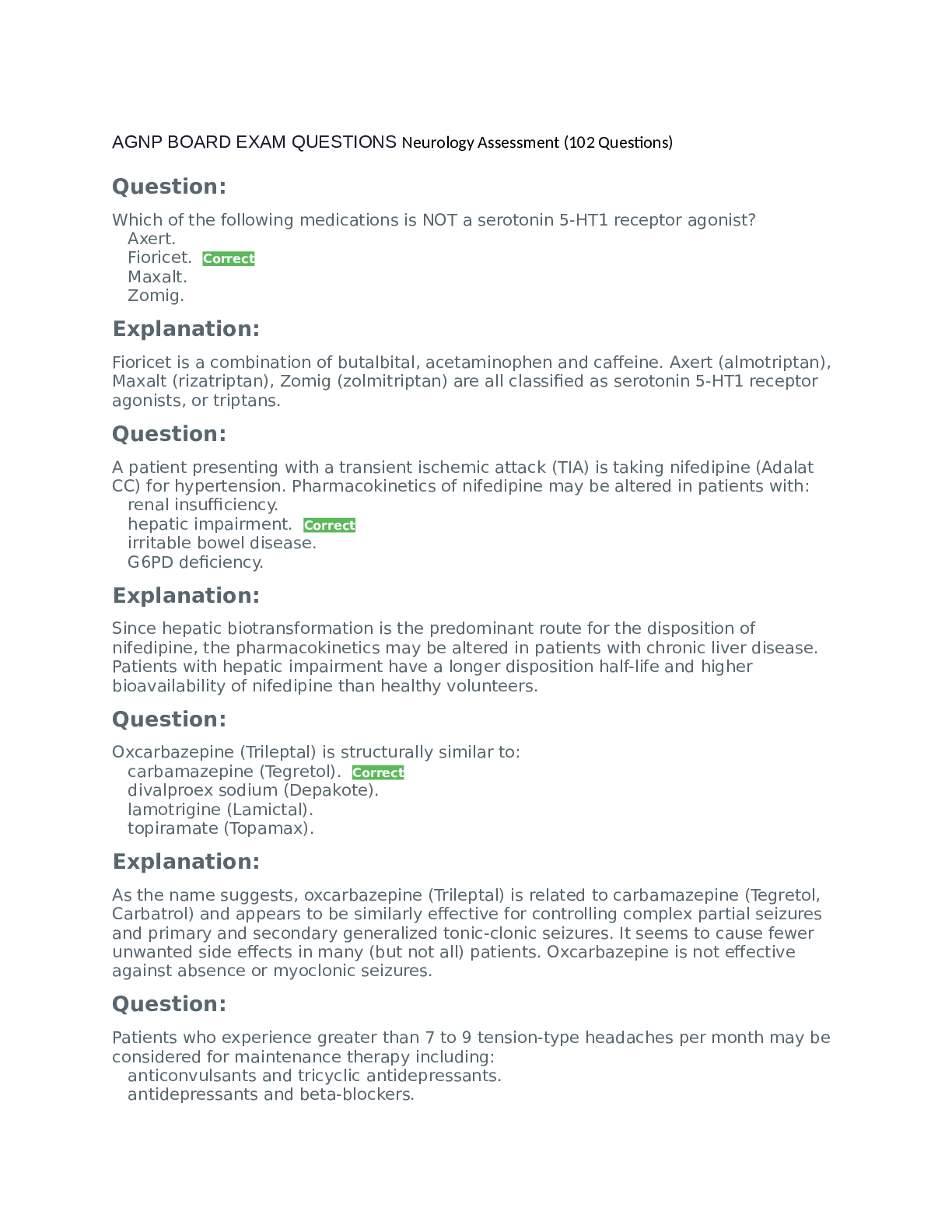
Reviews( 0 )
Document information
Connected school, study & course
About the document
Uploaded On
Apr 22, 2022
Number of pages
33
Written in
Additional information
This document has been written for:
Uploaded
Apr 22, 2022
Downloads
0
Views
64

.png)
.png)
.png)
.png)
.png)
.png)


